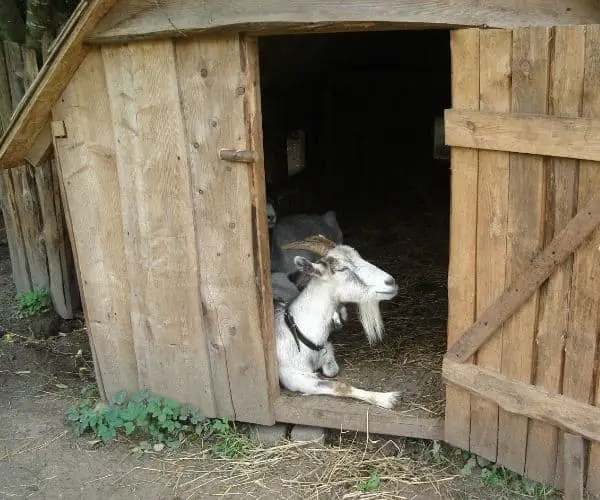A goat is a great animal to have on a homestead. Whether the goats are pets or being raised for resources, keeping a goat warm in the wintertime is easier than it sounds. Goats can tolerate cold weather well; it is easier to keep a goat warm than to stop them from overheating. The good news is that mother nature has already done most of the work for us.
Goats produce extra heat and have cashmere fur to help keep them warm in cold climates. The ordinary rule is that a goat can survive the same temperature as a human with heavy clothing. However, a goat can still get Hypothermia and other respiratory diseases in the cold.
The caprine species is adaptable to the cold weather better than us. Their digestive system helps provide extra heat to keep them warm; however, goats are still very vulnerable to upper and lower respiratory issues due to cold weather. When considering the different ways to keep a goat warm, you must understand that mother nature has already done most of the work for us.

How to Keep a Goat Warm in Cold Weather
Goats have a natural cashmere that grows in their fur to help keep them warm. While a goat can withstand sub-zero temperatures, a baby goat (Kids) would need a heater below 20 degrees Fahrenheit. An adequate shelter and a straw diet are also required to help a goat withstand cold weather.
Some people place their goats in a closed barn with heaters; others prefer to use a three-sided shed outdoors. The solution is going to depend on the area in which you reside. Goats fair better in cold environments than in hot ones.
A breeding doe and kids should be given extra attention during extreme climate changes. Goats produce excess heat and have cashmere fur to help keep them warm in cold environments. Kids' internal systems that are not fully developed can have a challenging time in cold climates. Extra stress on the doe can also cause the goat not to survive the season; a nursing doe should be paid extra attention.
There are several factors to consider when trying to keep a goat warm:
You Must Understand the Lay of the Land
The meteorology and Topography of your area affect how to keep your goats warm in cold weather. In some places, it is a dry cold, other a wet cold. In some places, it rains a lot, and in other areas, it hardly rains. This knowledge is the key to creating a cold weather plan for your goat.
Understanding the weather patterns in your location will help you prepare to keep your goats warm in cold weather. Depending on your global position depends on which direction the weather is moving. If you live in the continental US, you live in the midlatitude westerlies. The weather travels west mostly with a southward curving Coriolis in response to the rotation of the earth.
The Topography of the area is the second most important thing to consider. Topography affects rain patterns, wind speeds, weather intensity, temperature, humidity, windward and leeward (mountain facing winds). Having a general idea of the lay of the land should suffice in preparing to keep a goat warm in cold weather. Finally, you want to consider landforms in your area, are there any high mountains, canyons, or other geographic structures, between the goats and the wind.

You then build your systems according to the lay of your land. Making the barn doors facing away from the most extreme weather patterns in your region and understanding how the airflow system works will help ventilate the barn. You also want to create as much negative air space between the goat and the ground as possible by building a raised platform 4 to 8 inches above the ground.
Keep the Goat out of the Water
Living in a climate that producing heavy rains even seasonally will affect the goats' warmth. Providing a shelter with a roof and extra cover for the goats to hide in or around during a rainstorm is a proven method to combat frequent rains. Even a three-sided shelter is better than no protection. Ensure the shed is big enough for the herd to avoid overcrowding issues or provide multiple sheds.
Snowfall can also soak a goat's fur and cause frozen ears and feet. Keeping the goats in a ventilated barn with a straw bed will fix this issue. If the goats are kept in an area where their feet are buried in the snow consistently, they will undoubtedly become afflicted and require amputation. Goats playing atop the snowfall during exercise or social interactions should fare well in cold climates without losing limbs.
Goats should be exercised during the day to roam in a dry area and kept in a dry place overnight and during extreme weather. Check for drafts in the barn to ensure the goats will not develop pneumonia or other respiratory issues.
Watch this video on making diy goat shelter for homesteading in the winter.
10 Ways to Keep your Goats Comfortable During Cold Weather
- 1Provide heaters
- 2Insulate the barn itself
- 3Hire an expert for ventilation of the bar
- 4Raised hay beds
- 5Do not coat your goats (it cause hair loss, which hinders keeping them warm long term)
- 6Get rid of all the drafts in the barn
- 7Avoid overcrowding
- 8Provide raised covered play areas for kids
- 9Water heaters
- 10Clean the barn regularly
A Goats Diet is an Important Factor
A Goat has four stomachs that help process its last meal and turn it into food. The first of the four stomachs is called the rumen. The rumen is the goats' internal heater. A Goat needs plenty of roughage in the wintertime to fuel the heater. A Goat needs plenty of hay to survive the cold, but also oats sparingly.
The rumen is responsible for breaking down the roughage into a digestible substance. This process requires softening and fermentation of the straw. As the goat eats the straw, it becomes lined in the rumen portion of the digestive system. It takes at least a day of resting at the bottom of the rumen to soften the straw that will produce heat. Fresh straw and oats are layered on top of the old straw.
A Goat will produce about 305 cubic inches of gas that needs to be released by cud-chewing per hour, which provides some initial warmth. As the goat chews its cud, the refined straw returns to the rumen, and the microbes begin breaking down the cellulose and fermenting the straw. The heat from the fermentation process helps the goat produce a tremendous amount of body heat.
Goats need water to stay cool and warm. Since a goat does not like ice very much, it is best to serve the goat warm fresh, clean water several times a day or provide a heating device for the water to keep it at room temperature.
Conclusion
If your goats are appropriately fed with tons of roughage, they will produce enough body heat to survive most cold weather situations. The goat is sensitive to climate changes that happen too quickly, but if they have shelter, food, and water, most of the herd will survive the winter. Although they still need oats, increasing the straw feed in the wintertime will help keep the goats warm naturally.
